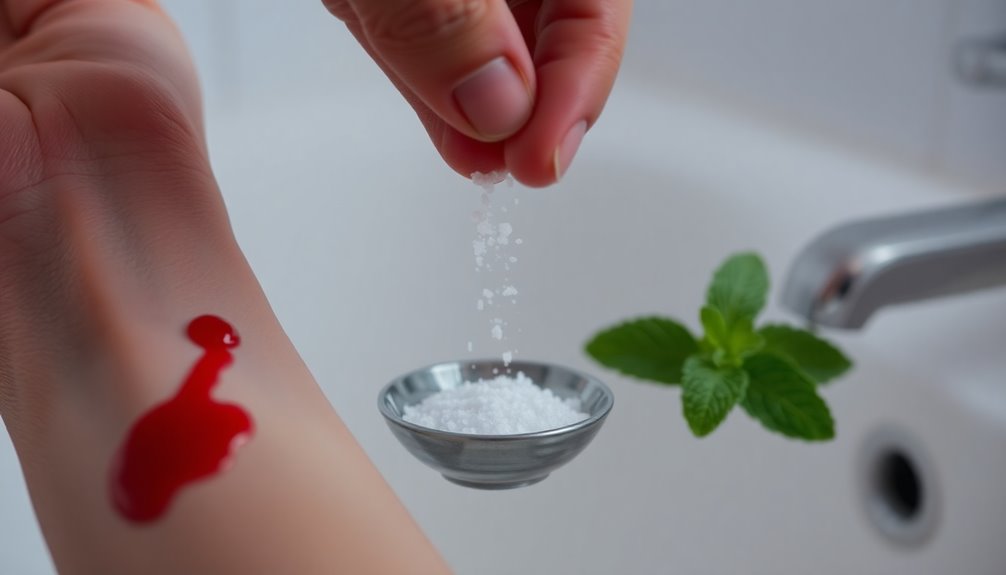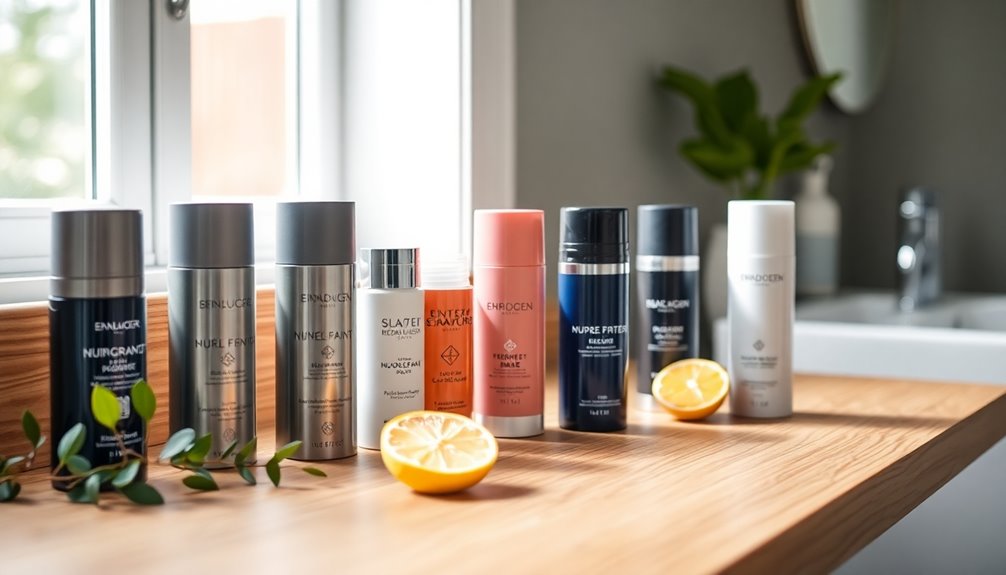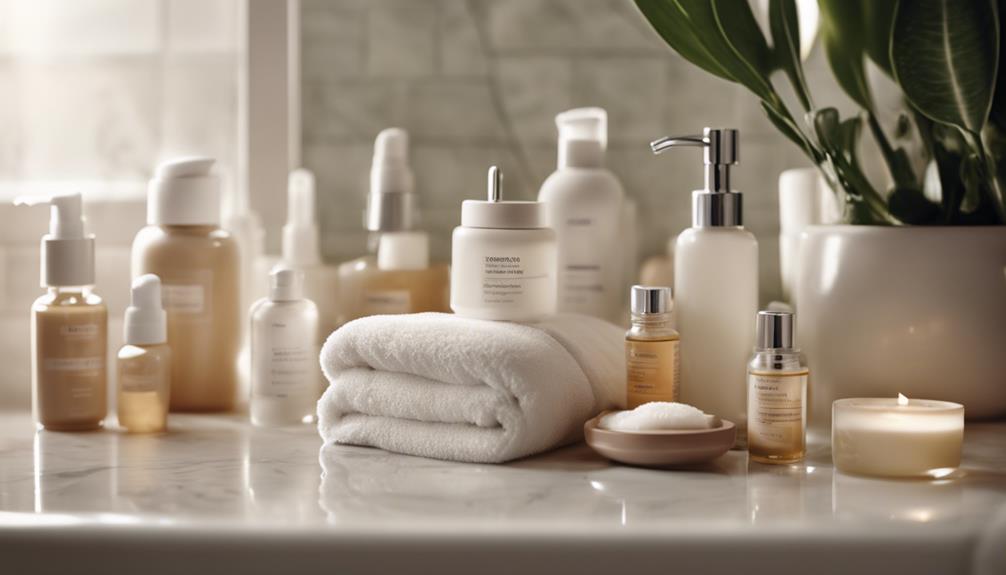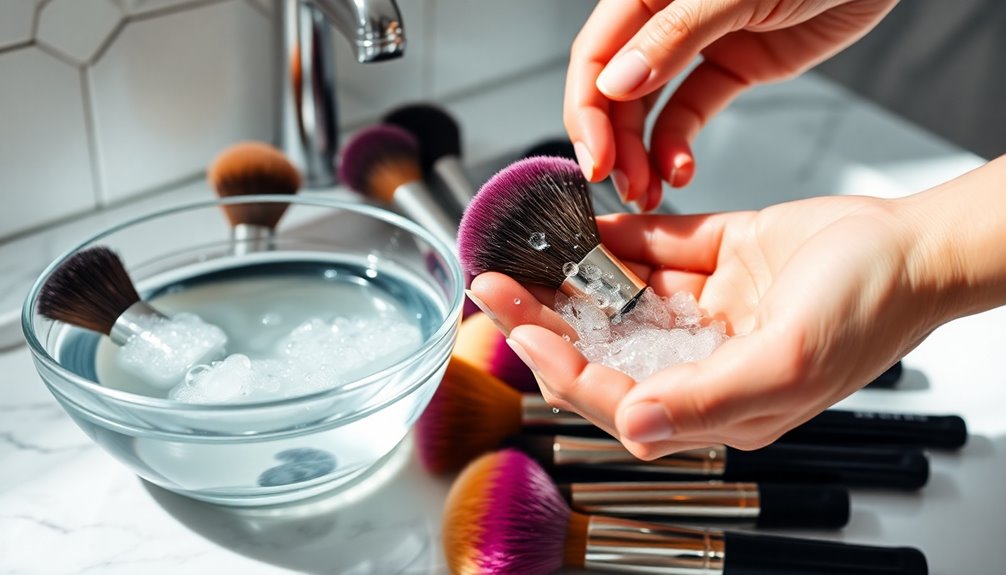If you ever find yourself with a razor cut, there's a bizarre but effective hack that truly works: apply deodorant with aluminum chloride. This ingredient helps constrict the blood vessels, effectively stopping the bleeding. First, rinse your cut with cool water to reduce blood flow, then gently apply the deodorant. You can also use a cold compress or ice wrapped in cloth for added effect. If that's not available, petroleum jelly can act as a barrier and help seal the wound. Intrigued by other unique solutions? There's more to explore about keeping those nicks at bay.
Key Takeaways
- Apply deodorant containing aluminum chloride to constrict blood vessels and effectively stop bleeding from razor cuts.
- Use mouthwash for its antiseptic properties to clean and help stop bleeding from cuts.
- Apply unused lip balm to create a protective barrier, promoting clotting and reducing blood flow.
- Utilize petroleum jelly to seal the wound, which can help stop bleeding and protect the area.
- Combine a cold compress or ice cubes with gentle pressure to constrict blood vessels and slow bleeding effectively.
Immediate First Aid Steps
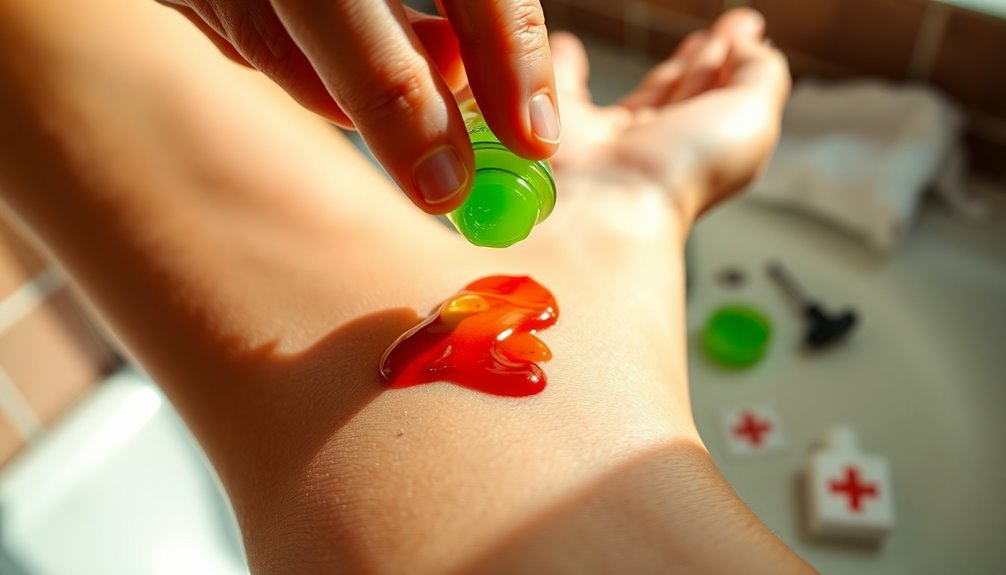
When you get a razor cut, acting quickly can make a big difference in stopping the bleeding. First, rinse the cut with cool water to help constrict the blood vessels and reduce bleeding. This also cleans away any debris, preparing the area for further treatment. Avoid hot water, as it can increase blood flow.
Next, consider using an antiseptic solution like hydrogen peroxide or rubbing alcohol to prevent infection. If you have aftershave lotion on hand, it can work too since it contains alcohol and acts as an astringent. Alternatively, a styptic pencil or alum block can help constrict blood vessels and promote clotting. Just be cautious with harsh products that could irritate your skin. Avoid hydrogen peroxide and iodine, as they can damage tissue.
Applying a cold compress or ice wrapped in a cloth can also effectively slow down the bleeding. Hold it against the cut for several minutes until the bleeding stops. This method works best when combined with rinsing and antiseptic applications. Following these immediate steps will set you up for better healing and minimize the risk of infection.
Apply Pressure Effectively
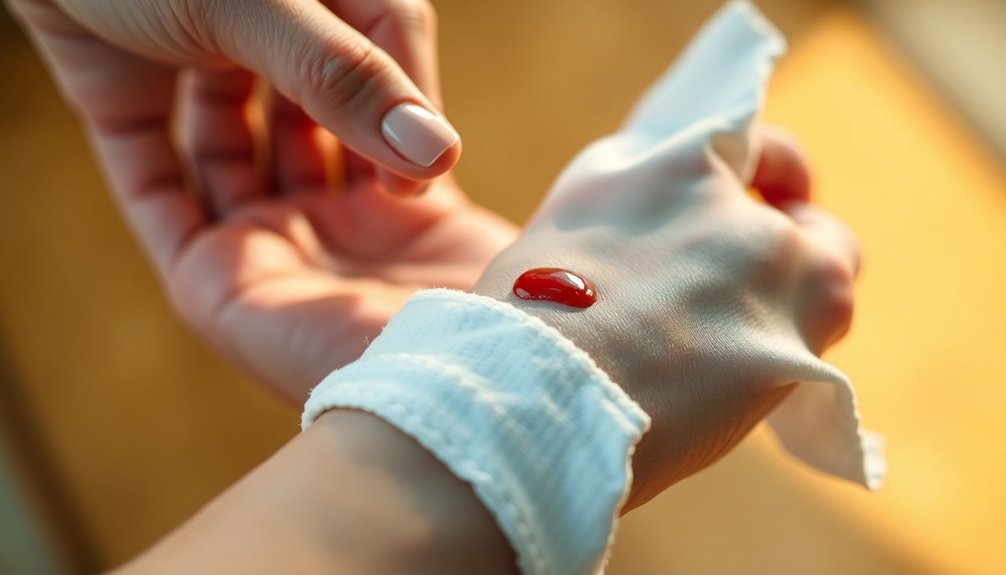
To effectively stop a razor cut from bleeding, start by applying firm pressure directly over the wound. Use a clean cloth or tissue—this keeps everything hygienic. Hold it there for about 3 minutes. This duration helps the blood coagulate, slowing the bleeding and kickstarting the healing process. Make sure the cloth hasn't been used for anything else to avoid any risk of infection.
While applying pressure, be gentle but firm. Think of it like holding a secret; you want to press down without aggravating the wound. Avoid rubbing or wiping the area, as this can make things worse. If the bleeding doesn't stop after 3-5 minutes, pinch the skin surrounding the cut with your thumb and index finger to apply additional pressure. Remember, a cold compress can also help constrict blood vessels and further reduce bleeding.
If you need to, you can also press down on the area below the wound to enhance the effectiveness. Remember, if the bleeding persists despite your best efforts, seek medical help immediately. Keep an eye on the wound afterwards for any signs of infection. Your priority is to control the bleeding and promote healing safely.
Cold Water and Compress Benefits
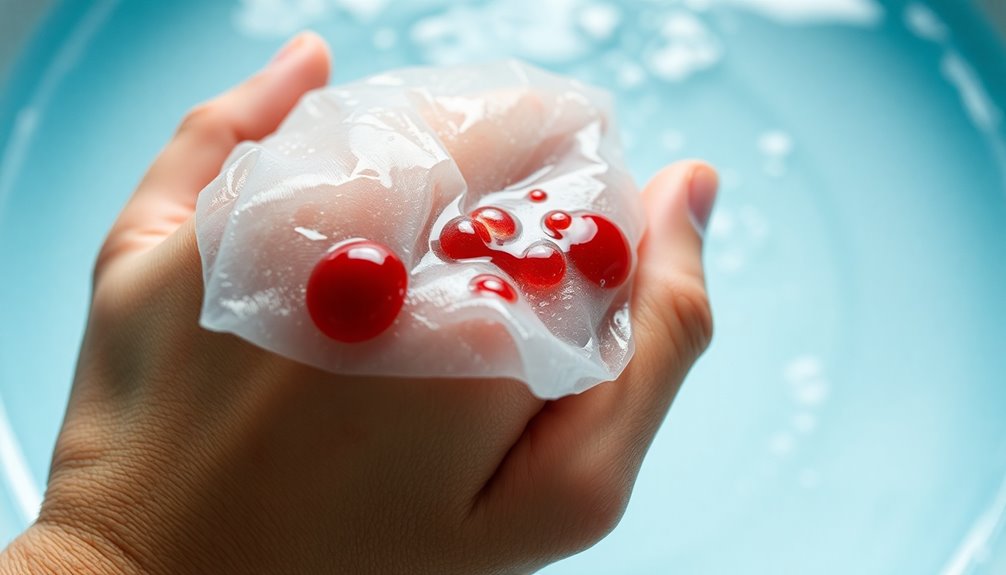
Cold water and compresses are invaluable tools for managing razor cuts. Rinsing the area with cold water constricts blood vessels, effectively slowing the bleeding. This makes it easier for a clot to form, giving your skin a chance to heal. Plus, splashing cold water on the cut offers a refreshing sensation that calms the skin and tightens pores, providing a crisp, clean finish.
For added effectiveness, apply a cold compress or an ice pack wrapped in a cloth directly to the cut. Holding it there for up to 30 seconds further constricts blood vessels, helping to minimize blood flow. If you don't have a compress on hand, ice cubes work just as well—just remember to wrap them in a cloth to avoid frostbite.
Combining cold water or a compress with firm pressure enhances your efforts to stop the bleeding. You can also use these methods alongside other treatments for even better results. Furthermore, proper preparation before shaving can significantly reduce the likelihood of experiencing cuts in the first place. So, next time you nick yourself while shaving, remember that cold water and compresses can make a significant difference in managing that pesky razor cut.
Using Styptic Pencil or Alum
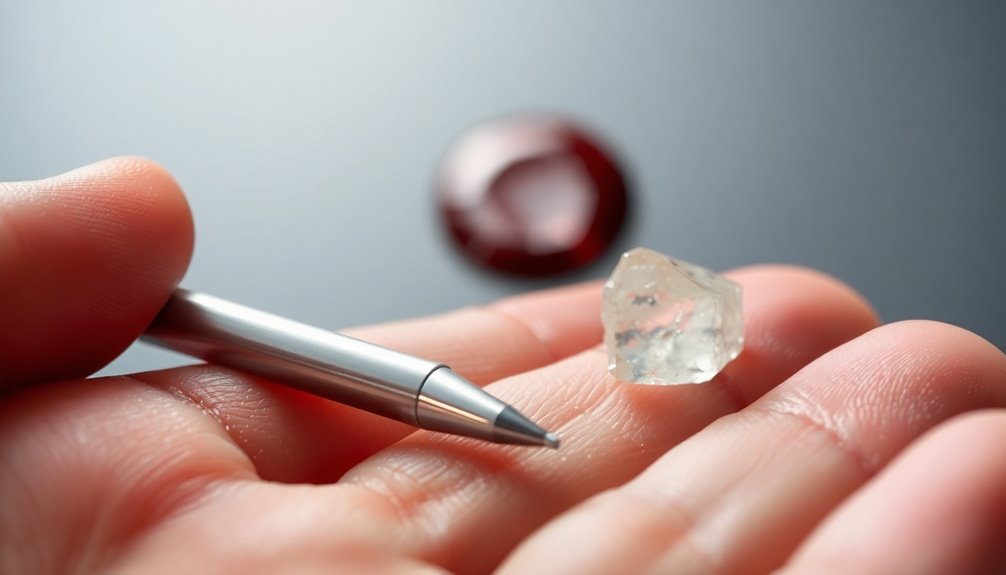
After managing a razor cut with cold water or compresses, you might want a quick solution to stop the bleeding effectively. A styptic pencil or an alum block can come to your rescue. Styptic pencils, made from aluminum sulfate, act as powerful astringents. To use one, wet the tip and apply it directly to the cut. You'll feel a stinging sensation, which means it's working, and the bleeding should stop within seconds. Rinse your face gently afterward to clear any residue.
Alternatively, you can use an alum block, a crystallized bar made from potassium alum. Simply wet your face, then rub the block over the cut. You may need a few passes to fully close the wound. Both options not only stop bleeding but also provide antiseptic properties reducing the risk of infection.
Styptic pencils work almost instantly and are portable, making them perfect for travel. Alum blocks are slightly less potent but still effective and help prevent razor burn. Both tools are essential for anyone who shaves, ensuring you can tackle minor cuts with confidence.
Natural Alternative Remedies
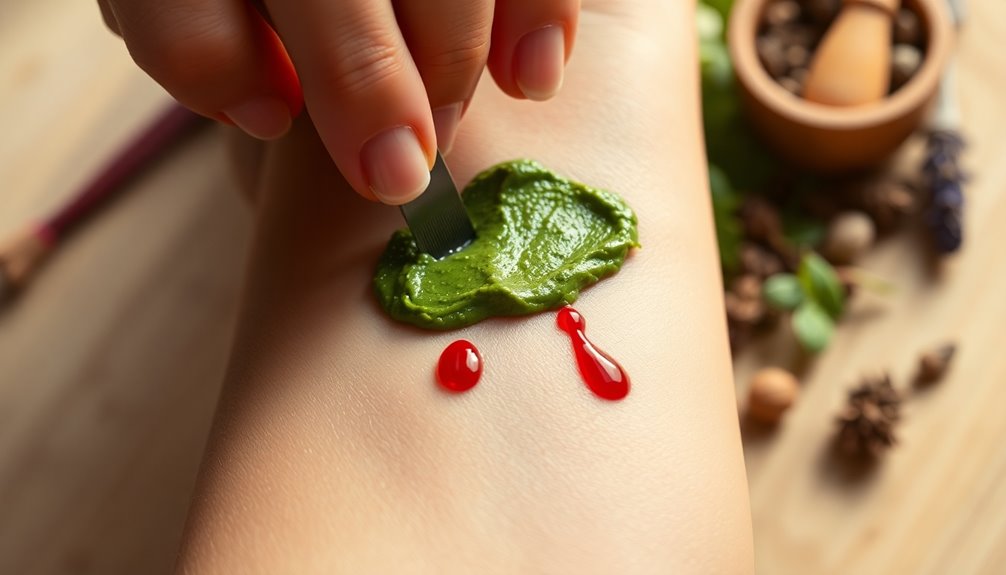
When you're looking for a natural way to stop a razor cut from bleeding, several remedies can effectively help. One popular choice is witch hazel, which constricts blood vessels and soothes the skin. Aftershave lotion can also work wonders due to its alcohol content, acting as an astringent to clean and constrict the wound. Alternatively, you can try deodorant, as its aluminum chloride helps stop bleeding.
For a quick solution, applying a cold compress or ice pack reduces blood flow to the area. If you have coffee or tea on hand, their caffeine and tannins can constrict blood vessels as well. Cayenne pepper is another potent option, promoting clotting through vasoconstriction. Additionally, using ice treatment can help cool the area, further promoting clot formation. Including turmeric's anti-inflammatory properties might also assist in reducing irritation around the cut.
You might also consider using a tea bag; it absorbs blood while the tannins work to stop bleeding. Petroleum jelly forms a protective barrier, and honey offers soothing properties, though it's not primarily a bleeding stopper. Lastly, aloe vera gel calms the skin and promotes healing, making it a great addition to your natural remedy toolkit. With these alternatives, you can effectively manage those pesky razor cuts without reaching for harsher chemicals.
Infection Prevention Techniques

Infection prevention is crucial for anyone dealing with cuts or scrapes, especially after a razor mishap. Start by washing your hands thoroughly before touching the wound. Rinse the cut with cool water to remove debris and lower the risk of infection. After that, apply an antiseptic solution like hydrogen peroxide or rubbing alcohol to eliminate bacteria. Once the area is clean, use a clean cloth or tissue to apply gentle pressure and stop any bleeding. It's also important to keep the cut clean and dry by washing it daily with mild soap and water.
It's essential to cover the cut with a sterile bandage to protect it from further contamination. Remember to keep the bandage clean and dry, washing the area daily with mild soap and water. Avoid sharing personal items, such as razors or towels, which can spread germs. If you're in a community or athletic setting, shower after practice, wash your uniforms, and report any infections promptly.
Also, remember to use gloves when changing dressings and dispose of them properly to prevent cross-contamination. Following these infection prevention techniques will help you stay safe and keep your cuts from getting worse.
Promoting Healing After a Cut
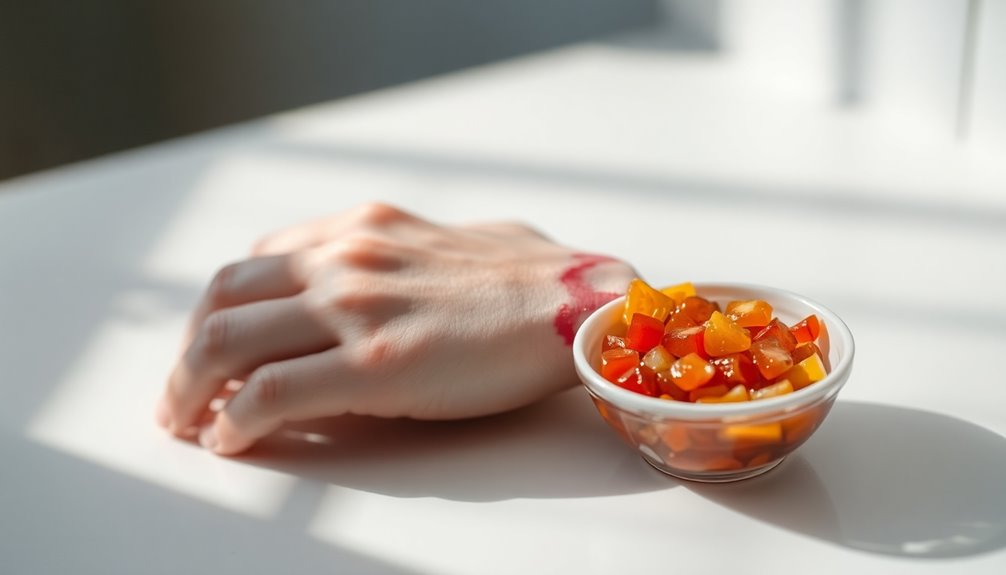
Proper care following a cut is vital for promoting healing. Start by cleaning the wound with saline solution or sterile water—these closely resemble your body's natural fluids. Avoid soap or tap water with additives, as they can irritate and dry out the wound. After showering, cover the wound and cleanse it again with saline. Maintain a balanced moisture level; it shouldn't be too dry or too wet. A thin layer of antibiotic ointment can help, but steer clear of triple antibiotic ointments that might irritate.
Nourishment plays a crucial role too. Consume a balanced diet rich in vitamin C, zinc, and protein to support healing. Including high-fiber foods like chia seeds can also aid digestion and promote overall health. Drink plenty of water to stay hydrated, as it aids cellular repair. Incorporate fruits, vegetables, and lean proteins into your meals, and include high-fiber foods to prevent constipation from pain medication. Additionally, be aware that healing time can vary, with smaller cuts healing in about a week while larger wounds may take up to a year.
Topically, consider applying aloe vera gel or medical-grade honey for their soothing and antibacterial properties. Avoid picking at the scab, as it can disrupt healing. Regularly change dressings and monitor for signs of infection, seeking medical help if necessary. This proactive care will significantly enhance your healing process.
Long-Term Shaving Prevention Tips

To keep razor bumps and irritation at bay, it's essential to adopt effective long-term shaving prevention tips. Start by understanding the direction of your hair growth. Look in the mirror and pull your skin tightly to identify how your hair grows. Shaving against the grain can lead to irritation, so always shave in the direction of hair growth. If your hair grows in different directions, consider gently brushing it daily with a toothbrush to train it to grow uniformly.
Shave when your hair is soft—ideally right after a warm shower. Use a moisturizing shaving cream to reduce friction and irritation. Make light, short strokes, and avoid pressing too hard on the blade. Rinsing the blade after each stroke helps to keep it clean and is important for preventing skin irritation during the shaving process. Understanding the importance of emotional awareness can also aid in recognizing how stress impacts the skin. Additionally, maintaining a healthy diet that includes essential vitamins can support skin health and resilience. Keep in mind that using high-quality blades can also contribute to a smoother shave.
Post-shaving, apply a soothing aftershave to minimize razor bumps. Rinse off the cream with warm water and use a cool, damp washcloth on your skin. Regularly clean and replace your razors, using high-quality blades to ensure an effective shave. Lastly, consider shaving more frequently, as this can help prevent hair from curving and causing bumps.
The Bizarre Hack Explained

After mastering long-term shaving techniques, you might still encounter the occasional razor cut. When that happens, you can turn to some unconventional products that surprisingly work wonders. For instance, a thin layer of deodorant containing aluminum chloride can constrict blood vessels and stop the bleeding quickly. Just apply it with your finger to the nick.
If you have mouthwash handy, it can also do the trick due to its antiseptic properties. Though it might sting a bit, it’s effective in an emergency. Similarly, a dab of unused lip balm creates a protective barrier that promotes clotting while moisturizing the skin. Additionally, applying pressure to the cut immediately is essential for aiding in clotting and minimizing blood loss. Furthermore, once the bleeding has stopped and the cut is on its way to healing, maintaining oral hygiene can play a role in preventing infection. Using mouthwash not only helps keep your mouth fresh but also showcases some unexpected benefits, such as helping to soothe any irritation around the wound. Interestingly, while you’re taking care of cuts, you might also consider the crest whitening strips benefits for enhancing your smile, as they can effectively remove stains and brighten your teeth without causing additional discomfort.
You can even use petroleum jelly for its versatile benefits. A tiny amount placed on the cut can help seal the wound and stop the bleeding.
For immediate relief, a cold compress or ice cubes can constrict blood vessels and slow down the bleeding. Just apply it gently for a few minutes. Firm pressure with a clean cloth is crucial too; hold it down softly over the cut to encourage clotting. With these bizarre hacks, you'll be well-equipped to handle those pesky razor cuts!
Frequently Asked Questions
Can I Use Regular Ice Instead of a Cold Compress?
Yes, you can definitely use regular ice instead of a cold compress. Ice cubes constrict blood vessels, which helps reduce bleeding effectively. Just wrap the ice in a soft cloth to avoid skin damage and hold it against the cut for 20-30 seconds. If you don't have a cold compress handy, this method works quickly to calm the bleeding. Just remember to clean the area afterward and apply antiseptic to prevent infection.
How Long Should I Wait Before Applying Antiseptic Cream?
You should wait until the bleeding has stopped or significantly slowed down before applying antiseptic cream, which usually takes about 5-10 minutes for minor cuts. Make sure to clean the area gently first, and avoid using antiseptic on open wounds with active bleeding. Once the bleeding is controlled, gently apply a thin layer of antiseptic to promote healing while keeping the wound clean and protected from infection.
Is It Safe to Shave Over a Healing Cut?
No, it's not safe to shave over a healing cut. Shaving can irritate the wound, increase the risk of infection, and disrupt the healing process. If you must shave, wait until the cut is fully healed. Always use clean razors and apply gentle pressure to avoid reopening the wound. Consider alternative hair removal methods like trimming or waxing instead to protect your skin and promote faster healing. Your skin will thank you!
What Should I Do if the Bleeding Doesn't Stop?
If the bleeding doesn't stop after applying pressure for 5-10 minutes, it's time to take further action. Pinch the skin around the cut with your thumb and index finger, applying pressure both above and below the wound. If it's still bleeding, consider using a styptic pencil or an astringent to help constrict blood vessels. Don't hesitate to seek medical assistance if the bleeding remains profuse or persistent. Your safety comes first!
Can I Apply Makeup Over a Fresh Cut?
You shouldn't apply makeup over a fresh cut. Doing so can trap bacteria, increasing the risk of infection and prolonging healing. Makeup can dry out the wound, which is harmful since it needs moisture to heal properly. Additionally, applying makeup too soon can irritate the skin and interfere with your body's natural healing process. It's best to wait until the cut has fully closed before resuming your makeup routine.
Conclusion
Next time you nick yourself while shaving, don't panic. By applying pressure, using cold water, or trying a styptic pencil, you can stop the bleeding quickly. Explore natural remedies for extra support, and always keep an eye on your cut to prevent infection. Promote healing with proper care, and consider long-term shaving strategies to avoid future mishaps. With these tips and the bizarre hack in your toolkit, you'll be ready to tackle those razor cuts like a pro!
